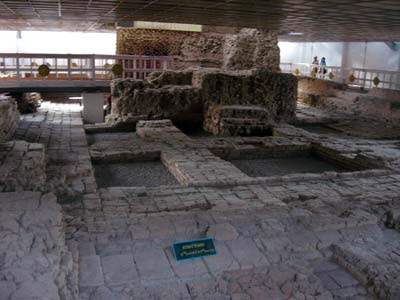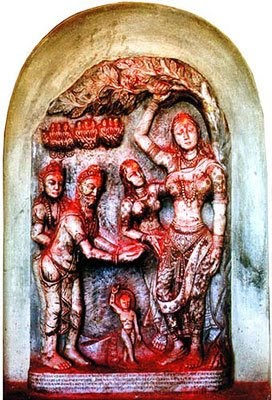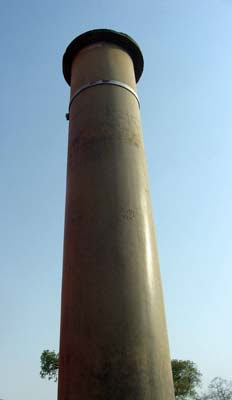Lumbini (Sanskrit: लुम्बिनी, "the lovely") is a Buddhist pilgrimage site in the Kapilavastu district of Nepal, near the Indian border. It is the place where Queen Mayadevi is said to have given birth to Siddhartha Gautama, who in turn, as the Buddha Gautama, gave birth to the Buddhist tradition. The Buddha lived between roughly 563 and 483 BCE. Lumbini is one of four magnets for pilgrimage that sprang up in places pivotal to the life of the Buddha, the others being at Kushinagar, Bodh Gaya, and Sarnath.
Lumbini is in the foothills of the Himalaya, 25 km east of the municipality of Kapilavastu, where the Buddha is said to have lived till the age of 29. Kapilvastu is the name of the place in question as well as of the neighbouring district. Lumbini has a number of temples, including the Mayadevi temple, and others under construction. Also here is the Puskarini or Holy Pond - where the Buddha's mother took the ritual dip prior to his birth and where he, too, had his first bath - as well as the remains of Kapilvastu palace. At other sites near Lumbini, earlier Buddhas were, according to tradition, born, achieved ultimate awakening and finally relinquished earthly form.


In the Sutta Nipáta (vs. 683) it is stated that the Buddha was born in a village of the Sákyans, in the Lumbineyya Janapada. The Buddha stayed in Lumbinívana during his visit to Devadaha and there preached the Devadaha Sutta.

The holy site of Lumbini is bordered by a large monastic zone, in which only monasteries can be built, no shops or hotels or restaurants. It is separated into an eastern and western monastic zone, the eastern having the Theravadin monasteries, the western having Mahayana and Vajrayana monasteries.
The holy site of Lumbini has ruins of ancient monasteries, a sacred Bodhi tree, an ancient bathing pond, the Asokan pillar and the Mayadevi temple, where the precise place of birth of Buddha is located. From early morning to early evening, pilgrims from various countries perform chanting and meditation at the site.
The birthplace of the Gautama Buddha, Lumbini, is the Mecca of every Buddhist, being one of the four holy places of Buddhism. It is said in the Parinibbana Sutta that Buddha himself identified four places of future pilgrimage: the sites of his birth, enlightenment, first discourse, and death. All of these events happened outside in nature under trees. While there is not any particular significance in this, other than it perhaps explains why Buddhists have always respected the environment and natural law.

 The bas relief above depicts Maya Devi with her right hand holding on to a branch of a sal tree with a newborn child standing upright on a lotus petal, shedding an oval halo, around his head, while two celestial figures pour water and lotuses from vessels of heaven as indicated by the delineation of clouds. This nativity scene was installed by Malla Kings of the Naga dynasty from about the 11th to 15th Century in the Karnali zone of Nepal.
The bas relief above depicts Maya Devi with her right hand holding on to a branch of a sal tree with a newborn child standing upright on a lotus petal, shedding an oval halo, around his head, while two celestial figures pour water and lotuses from vessels of heaven as indicated by the delineation of clouds. This nativity scene was installed by Malla Kings of the Naga dynasty from about the 11th to 15th Century in the Karnali zone of Nepal. 

It is pointed out by scholars that the temple of Maya Devi was constructed over the foundations of more than one earlier temple or stupa, and that this temple was probably built on an Ashokan stupa itself.
Recently, several beautiful shrines have been built by devotees from Buddhist countries. A visit to Lumbini, the birthplace of Buddha, is not only for spiritual enlightenment but also for solace and satisfaction that one gets in such a calm and peaceful place.
 Discovered by the now famous German archaeolgist Dr. Fuhrer, the pillar is the first epigraphic evidence relating to the life history of Lord Buddha and is also the most visible landmark of the garden. The historic importance of the pillar is evidenced by the inscription engraved in the pillar (in Brahmi script). It is said that the great Indian Emperor Ashok visited the site in the twentieth year of is ascendancy to the throne and as a homage to the birthplace,erected the pillar. The inscriptions in the pillar roughly translates as: Kin Piyadesi beloved of th Gods, having been anointed 20 yeas, came himself and worshipped saying Here Buddha Shakyamuni was born: And he caused to make a stone (capital) representing a horse; and he caused (this) stone pillar to be erected. Because the worshipful one was born in the village of Lumbini has been made free of taxes and recipient of wealth"
Discovered by the now famous German archaeolgist Dr. Fuhrer, the pillar is the first epigraphic evidence relating to the life history of Lord Buddha and is also the most visible landmark of the garden. The historic importance of the pillar is evidenced by the inscription engraved in the pillar (in Brahmi script). It is said that the great Indian Emperor Ashok visited the site in the twentieth year of is ascendancy to the throne and as a homage to the birthplace,erected the pillar. The inscriptions in the pillar roughly translates as: Kin Piyadesi beloved of th Gods, having been anointed 20 yeas, came himself and worshipped saying Here Buddha Shakyamuni was born: And he caused to make a stone (capital) representing a horse; and he caused (this) stone pillar to be erected. Because the worshipful one was born in the village of Lumbini has been made free of taxes and recipient of wealth" In general, 'Buddha' means 'Awakened One', someone who has awakened from the sleep of ignorance and sees things as they really are. A Buddha is a person who is completely free from all faults and mental obstructions. There are many people who have become Buddhas in the past, and many people will become Buddhas in the future.. There is nothing that Buddha does not know. Because he has awakened from the sleep of ignorance and has removed all obstructions from his mind, he knows everything of the past, present, and future, directly and simultaneously. Moreover, Buddha has great compassion which is completely impartial, embracing all living beings without discrimination. He benefits all living beings without exception by emanating various forms throughout the universe, and by bestowing his blessings on their minds. Through receiving Buddha's blessings, all being, even the lowliest animals, sometimes develop peaceful and virtuous states of mind. Eventually, through meeting an emanation of Buddha in the form of a Spiritual Guide, everyone will have the opportunity to enter the path to liberation and enlightenment.
In general, 'Buddha' means 'Awakened One', someone who has awakened from the sleep of ignorance and sees things as they really are. A Buddha is a person who is completely free from all faults and mental obstructions. There are many people who have become Buddhas in the past, and many people will become Buddhas in the future.. There is nothing that Buddha does not know. Because he has awakened from the sleep of ignorance and has removed all obstructions from his mind, he knows everything of the past, present, and future, directly and simultaneously. Moreover, Buddha has great compassion which is completely impartial, embracing all living beings without discrimination. He benefits all living beings without exception by emanating various forms throughout the universe, and by bestowing his blessings on their minds. Through receiving Buddha's blessings, all being, even the lowliest animals, sometimes develop peaceful and virtuous states of mind. Eventually, through meeting an emanation of Buddha in the form of a Spiritual Guide, everyone will have the opportunity to enter the path to liberation and enlightenment. It is impossible to describe all the good qualities of a Buddha.
 A Buddha's compassion, wisdom, and power are completely beyond conception.
A Buddha's compassion, wisdom, and power are completely beyond conception. Getting there and around
Buses run regulary after every hour or so from morning six o' clock to afternoon five o' clock to Lumbini from Bhairawa, an industrial town situated 284 km to the southeast of Lumbini. They are crowded and slow: it almost takes an hour for the 22km trip. You can hire a cab for the day for about US$15. The cost may sound little bit expensive, but it's worth spending if you are travelling in a small group. The other option is you can hire a three-wheeler tempo for about half the price.
You can also take a 45-minute flight from Kathmandu to Gautam Buddha Airport at Bhairawa: there are five flights a week for US$75.
Depending on how long you want to stay in Lumbini, a bicycle or hiring a rickshaw would be nice to go around but not necessary (expecially for the fact that one cannot find a bike for rent easily).

No comments:
Post a Comment